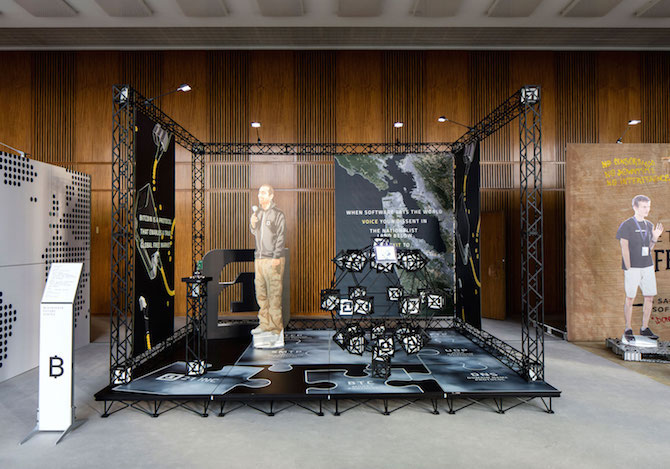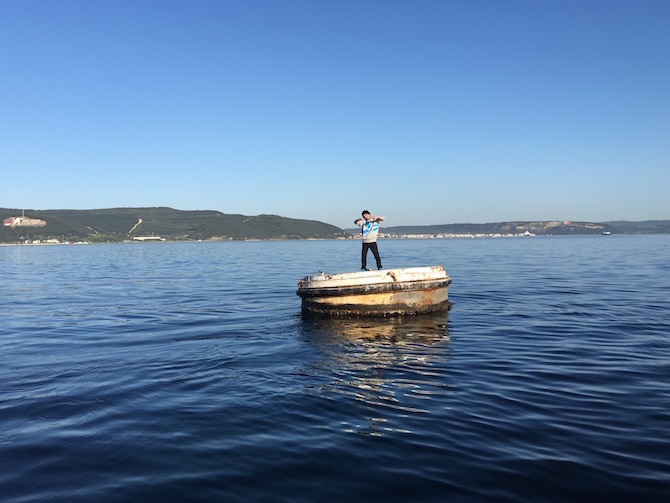Search
To search for an exact match, type the word or phrase you want in quotation marks.
A*DESK has been offering since 2002 contents about criticism and contemporary art. A*DESK has become consolidated thanks to all those who have believed in the project, all those who have followed us, debating, participating and collaborating. Many people have collaborated with A*DESK, and continue to do so. Their efforts, knowledge and belief in the project are what make it grow internationally. At A*DESK we have also generated work for over one hundred professionals in culture, from small collaborations with reviews and classes, to more prolonged and intense collaborations.
At A*DESK we believe in the need for free and universal access to culture and knowledge. We want to carry on being independent, remaining open to more ideas and opinions. If you believe in A*DESK, we need your backing to be able to continue. You can now participate in the project by supporting it. You can choose how much you want to contribute to the project.
You can decide how much you want to bring to the project.

After three months of the Biennale, we talk to Marco Roso, a member of the collective DIS, the curators responsible for the ninth edition of the Berlin Biennale 2016, #BB9. We met him at the Faculty of Fine Art in Barcelona, studying to be an artist, and followed his virtual trail when he established himself in New York, through the activities and contents generated by DISmagazine in the digital world. Now we share this interview reflecting on art as a form of political energy to generate futures. Along with Lauren Boyle, Salomon Chase and David Toro, the particular critical spirit of DIS distances itself from market speculation, vindicating other forms and experiences of the concept of art and the art object made evident in the selection of projects and new productions that this international event presents.
The project DIS, the embryo of this Biennale, wagers on new forms of creation, shunning the sovereign conditions of global capitalism. For them, the sharpness of the image is the connector for critical creation, Internet the means, and the democratisation of the creative forms an evident objective in their ideological trajectory. Part of this particular form of creating and managing the potential of art structures the organisation and the social dynamics of the Berlin Biennale programme. DIS is a specialist in establishing connections between art and publicity, fashion, communication and popular culture via the digital world.
With Marco Roso, as the voice of the DIS collective on this occasion, we trace some subjects of the biennale that the press has covered extensively, praising but also questioning a programme centred on the tension between digital culture and financial capital, the rational dilemma or the experience of a present that calls for nostalgia-free futures.
To being, a question more appropriate for conclusions, that’s hoping for a spontaneous response: an art biennale is an event that tends to repeat patterns and features, in your case what was it important to avoid in this ninth edition?
The truth is that we had no intention of avoiding anything in particular; we’ve simply worked on the Biennale in the same way as we work with our online magazine dismagazine.com. We’re editors and generators of content more than curators. We trained as artists but what we are interested in is exploring new formats rather than using schemas from the past.
On the other hand, the Berlin Biennale has a very specific DNA and in Berlin particularly part of the task of the “curator” is to connect the content or concept of the Biennale with the city. In this case, from the very first day we knew we weren’t interested in a nostalgic, romantic vision of Berlin, so much as quite the opposite. Whether we like it or not, we were more interested in showing a neoliberal, contemporary Berlin, that forms part of a globalised and neo-capitalist world, hence why we focussed on the centre of the city where the continuous flow of capital, tourism and powers that be are visible.
One detects the underlying idea of the biennale is that the present is unrecognisable due to the constant predicting of the future through quantifiable data that directly affect said present. This is an idea treated extensively by the philosophers Armen Avanessian and Suhail Malik. Did DIS subcontract the theoretical-philosophical part of the Biennale to such thinkers and their ruminated condition of post-contemporary and post-capitalism?
No, we haven’t subcontracted to anybody; it is simply as a question of elective affinities and amplifying their voice through the platform of the Biennale and dismagazine.com. For years now we’ve had relationships with Suhail y Armen, and without having to commune fully with their thesis we have had an interest in knowing more about accelerationism and related subjects. They are theorists who distance themselves from a certain melancholy of the traditional left and try to seek new ideological reformulations. In fact, already three years ago, we organised a roundtable discussion in New York with several of these thinkers and since then we’ve maintained a mutual relationship of attraction, curiosity and influence.

Some critics question the Biennale as lacking empathy with the city and its dense historical memory. Although the engaged choice of the sights of the exhibition, and the clear reading regarding their conversion into a theme park should undoubtedly be heeded as a wide-ranging critique. What is your reading of the city, or the choice of the locations?
Berlin is obviously no longer Berlin of the nineties. In Mitte –the centre of the city– as a result of the gentrification many of the spaces that were left empty and potentially available as locations in past biennales are now hotels, spas or luxury apartments. To find these alternative spaces, currently one has to travel to more peripheral districts and participate in this cycle of the gentrification of the city. We never had any interest in the biennale functioning as a gentrifying entity, quite the contrary, we’ve preferred to underline the present, very noticeable changes in the city and its political spectrum, hence why we chose to look for locations in Mitte.
Two key sites are the Akademie der Kunste (AdK) and ESMT (European School of Management and Technology). The first is a building of corporate architecture that houses the art academy in Pariser Platz. What attracted us to this place is its location in the symbolic epicentre of everything that is happening in Germany and globally. From the building you can see the usual protests, sometimes groups of Syrians and on others Turkish demonstrators mixed up with the hordes of tourists taking selfies in front of the Brandenburg gate. Everything in front of what the apparently innocuous setting of the Pariser Platz represents. The theatricality I’m referring to is the buildings surrounding AdK, a whole network of corporations and national powers. Some of these are: the American Embassy, the Comerz Bank, the building of the insurance company Allianz, the DZ Bank, where amongst other corporations there are the offices of Lockheed Martin (the largest arms manufacturer in the world) as well as all the lobbies one can imagine and the luxury hotel where Michael Jackson dangled his son from the balcony.
ESMT (European School of Management and Technology) was where the state council of the ex-Germany Democratic Republic was housed. This building still conserves its communist iconography but is currently a private business school, sponsored by large corporations. It’s somewhat shocking to see the stain-glass windows with a socialist realism alongside screens that show the fluctuations of the stock market in Frankfurt. Clearly, it is one of the buildings with a dense, weighty historical and political past. In this building, one has to highlight the site-specific contributions by Katia Noviskova, GCC and Simon Deny. The installation by Simon Deny, also made specially for ESMT, enters brilliantly into the relations of the historical past and present of this building and the possible future states that could result from the use of new technologies such as blockchain (a protocol that uses the currency Bitcoin).

In the show there is a piece that deals specifically with the crisis of the refugees in Europe, Homeland, by Halil Altindere. Moreover, war, terror, and surveillance are in the pieces by Hito Steyerl or Josh Kline, amongst others. Why do you think the biennale’s empathy with real political problems has been criticised?
I’m not sure whether or not the biennale’s empathy with political problems has been questioned, but what I can state is that the majority of the projects talk about real political problems even if they don’t do so in a militant or literal way. As I understand it, all the projects have a strong political content, the only difference is that many of the works at first sight are not overtly militant or don’t have the appearance of “political art” to which we are accustomed. Instead, given its intrinsic complexity they participate with a positive ambiguity that amplifies the readings of the works.
To enjoy this biennale takes time, one needs two days at least, and if one only sees it during the opening or during a couple of hours it’s possible that the impression the visitor takes away is the wrong one. However, this first erroneous impression is also interesting as one sees how a certain “public” has felt very uncomfortable and projected their anxieties.
The Biennale is an enormous project. How much time, have the four of you spent in Berlin?
The first year we were between Berlin and New York, the second year we moved permanently to Berlin so I believe we’ve spent more or less a year and three months here.
In monetary terms and terms of intellectual satisfaction, what has been the number of visitors and participants? Have there been many benefits or on the contrary just a return of the investment?
The directors of the Biennale told me that they hoped to have more than one hundred thousand visitors and the web, which is another platform of the Biennale, has had 160.000 visits a month.
We didn’t take on this commission as a professional perspective, more as a vocational one, like with the magazine. I can’t talk in monetary terms or benefits, other than in terms of experiences. For us, the best part of the conception of this Biennale has been the intellectual stimulus, the friendships and ties created by working with the artists and the Biennale team. Taking the risk to commission fifty new productions, seeing them materialise and how the selection of the projects granted a coherent voice to the Biennale has been a very gratifying experience that wouldn’t have been possible without the enthusiasm of all the participants. It will probably be the first and last Biennale we curate, but it has been an unforgettable experience that will always remain with us.
As a colophon, The Present in Drag, a hyperbolic figure of an accelerated present in the extreme, has permitted DIS a debut in both political and aesthetic material, firmly manifesting the problems and contradictions of contemporary art of the present and generating through this Biennale a platform for launching and promoting strategically open infrastructures.

Pilar Bonet Julve is a researcher and teacher. She has a degree in Medieval History and a PhD in Art History from the UB, where she teaches contemporary art and design, art criticism and curating. She is interested in the overflowing and political spaces of art, she is not motivated by heraldic criticism or the vase exhibition. A specialist in the life and work of the Catalan medium and artist Josefa Tolrà, she follows in the footsteps of visionary women as an experience of new humanity. She has recently presented exhibitions on irregular creativity: Josefa Tolrà and Julia Aguilar, Les Bernardes de Salt; ALMA. Médiums i Visionàries, Es Baluard Museum, Palma; La médium i el poeta. An astral conversation between Josefa Tolrà and Joan Brossa, Fundació Brossa. Writing and editing pacifies his soul. She manages the research group Visionary Women Art [V¬W].
www.josefatolra.org
@visionarywomenart
@josefatolra
@pilarbonetjulve
@artscoming
"A desk is a dangerous place from which to watch the world" (John Le Carré)